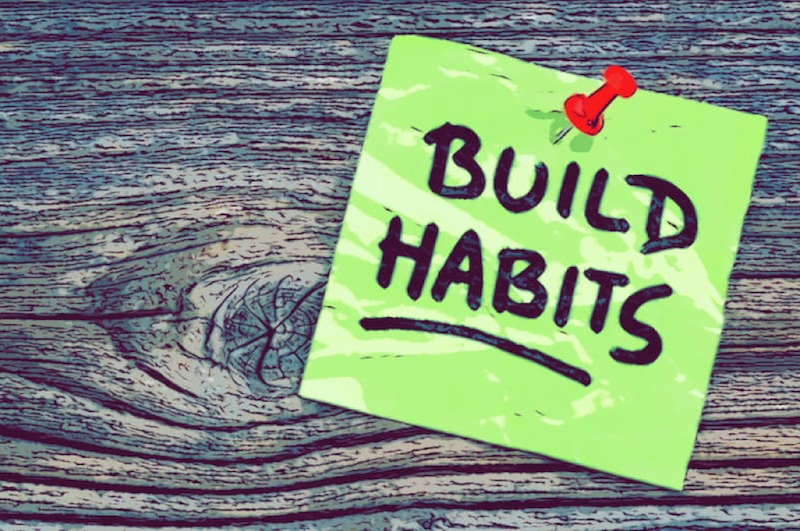Principles and Tactics for Building Good Habits

We are creatures of habit.
Much of what we do daily can be attributed to habits. Wendy Wood, Psychologist, and Professor of Business at the University of Southern California, estimates that 43% of our actions are performed daily and usually in the same context. In her research, people typically report that they don't even think about these repeated behaviors while they're doing them.
Our brain is always looking for ways to make behavior more automatic. This allows it to conserve effort so our cognitive resources can be used for other things. Imagine if you had to think hard about every single thing you did. Most of your day would be like trying to pick which restaurant to go to.

That would be exhausting.
Thankfully, nature has given us protocols to automate many of our behaviors and turn them into what we know as habits.
Habits handle many of the activities we do each day. With each repetition of specific behaviors, small changes occur in the brain, and neural connections associated with those behaviors become stronger and more predictable over time. This decreases the resistance it takes to execute certain behaviors, and they become automatic and easy for us to repeat.
Habit formation happens whether we think about it intentionally or not. Our minds mainly pick up on the consistency of actions, not necessarily how beneficial those actions are.
If we do something consistently, our minds will work to make those actions automatic, regardless of whether those actions are good for us or not. But we don't always naturally do things that benefit us, so we don't automatically form good habits. For most of us, we have a combination of good and bad habits.
When we think of good habits, we think of behaviors that, over time, give us benefits. Having good eating or fitness habits, for example, causes you to be more healthy over time. Good writing habits allow you to produce more over time. Good organizational habits enable organizations to be more productive over time. James Clear, the author of Atomic Habits, writes, "Good habits make time your ally. Bad habits make time your enemy."
But many of the habits we consider good comes from thinking ahead, usually in pursuit of a longer-term goal or supporting a value we hold. So to improve your chances of achieving these types of pursuits, you need to form positive habits which make those actions easier to execute over time.
While having good habits is great in theory, if it were easy, all we would have to do is think about forming better habits, and everyone would automatically have them. So adding good habits is easier said than done.
But while adding good habits isn't effortless, it can be made easier by using a proper framework. Therefore, we will cover some concepts to think about when adding habits and introduce a protocol to implement them.
Limbic Friction
I've written about how hard change is for us while learning a new skill, personal development, and changing organizational culture.
Over time our nervous system becomes customized to our unique experiences. As we learn, we form new connections, and parts of our brains that are used more often become more developed.
We are wired to develop stability once we find something that works (usually by repeating the same behavior). This is because once something has been made automatic, our nervous system wants to hold on to it unless it has a reason to change.
These connections become more stable over time, making it harder to change. This is why changing our behavior often comes with resistance. But that resistance can be overcome with effort and conscious override to change or add habits.
Neuroscientist Andrew Huberman has a term for this type of strain. He calls it "Limbic Friction." Limbic friction is the strain or effort required to overcome a lack of motivation or anxiousness to do something. He says that anytime we want to add or break a habit, we need to think about how much limbic friction is required.
For more minor changes, there will be smaller amounts of friction that will have to be overcome. But there will be more friction for more significant changes, which requires more effort.
Fortunately, there are certain times of the day when we naturally have more biological resources available to us to overcome higher amounts of friction.
Biological States
Huberman says that the first 8 hours after waking up is when our bodies tend to have the highest dopamine and adrenaline levels. During this time frame, your whole system is active and focused-oriented, which can help overcome limbic friction. Use this time for the most challenging habits.
While many consider dopamine the molecule of pleasure, it's actually the molecule of motivation. Our dopaminergic systems were developed to help us hunt and gather resources. So when we have naturally higher states, we have more motivation and drive to achieve our goals than later in the day when they become depleted.
Huberman says that you can combine this time of day with other things such as exercise, sunlight, cold exposure, caffein, and fasting, which place the brain and body into a state where you can engage in activities that require a high degree of effort.
After 8 hours, our dopamine and adrenaline levels start to come down. Serotonin is beginning to rise, resulting in a more relaxed state. This is typically a better time frame to implement habits that don't require as much limbic friction to overcome. Creative or relaxed work would fit in well during this period.
When we sleep is where most of our learning retention happens. So anything you are working on earlier in the day can be better maintained by getting a good night's rest.
Task Bracketing and Visualization
Understanding times of the day aren't just crucial for managing biological resources; Huberman says being consistent with implementing habits at the same time of day (and biological state) also helps the brain associate behaviors with context. This "primes" or gets the brain ready for specific actions, reducing limbic friction.
Your brain associates your behavior or habit with the sequence of events before and after. This bracket acts as a marker or cue for habit execution. Like warming up for exercise, your brain will be primed and ready when you do something roughly around the same time.
Once a habit forms at a particular time of day, it can be moved if you want. If habit sticks in a new context, it is context-independent and stronger.
Using procedural memory (memory of how to do something) helps overcome limbic friction as well. Performing the mental exercise of thinking through steps required to complete a habit from start to finish can improve your likelihood of performing that habit and decrease limbic friction.
Huberman says your nervous system knows the difference between thought and action, so just thinking about performing good habits won't actually give you good habits, but rehearsing can help dominos fall easier.
Six Week Protocol
Now that you have some concepts that will help you better prepare for limbic friction, you can use a specific protocol to install habits. Huberman gives a framework to start with based on research.
Write down six habits you would like to focus on for three weeks. Twenty-one days is the average amount of time it takes to form a habit. For some, it will vary, but you can start with twenty-one days as a benchmark. I would prioritize the behaviors by labeling them #1-6 most important to least important.
Huberman says you need to be very deliberate about forcing yourself to complete at least 4-5 per day during this time frame. Of course, the more days you can string together for the same habit, the better, but this gives you room for error.
Also, this is why prioritizing is helpful; stick to what you can manage and manage the most important. Don't try to make it up the next day if you miss a day. Just focus on getting a minimum of 4-5.
After the initial three weeks are complete, you will begin a new three-week maintenance cycle. During this cycle, stop forcing yourself to deliberately engage in your target habits and see which ones you stick to naturally or are more reflexive.
For the next three weeks, you will maintain the habits that stick and assess where you are at. After that, it's okay if they all didn't stick, but don't add any more habits during this time frame.
After three weeks of maintenance (six weeks total from the beginning), you can repeat a new six-week cycle with new habits or continue working on some that may have fallen off.
Six Week Protocol Summary:
- Write down six things you would like to work on deliberately for three weeks (weeks 1-3).
- Force yourself to complete a minimum of 4-5 per day (don't do more to "makeup" from the previous missed day, focus on one day at a time).
- After completing week 3, stop deliberately forcing yourself to execute habits.
- For the next three weeks (weeks 4-6), assess and maintain the habits that are happing naturally.
- Only add new habits after completing the six-week total cycle.
By thinking about principles that help overcome limbic friction and working in these cycles, you will form the most important habit - Getting in the habit of building habits. That habit will give you more control over the force that guides many of your daily actions and behaviors.
Footnotes:
- The Science of Making & Breaking Habits | Huberman Lab Podcast #53. This article is a VERY distilled version of this episode where Huberman cites multiple studies to draw his conclusions.
- Psychology of Habit by Wendy Wood and Dennis Runger